Are you planning to run a half marathon but feeling unsure about how to pace yourself for success? Proper pacing is key to maintaining a consistent effort throughout the full 13.1-mile distance, conserving energy, and achieving your personal time goals. In this article, we’ll guide you through the best half marathon pacing strategies to apply in your next race.
From determining your half marathon pacing to exploring different strategies, we’ll provide you with the knowledge and tools you need to tackle the challenging aspects of the course and cross the finish line feeling strong and accomplished. Let’s get started on the path to a successful half marathon!
Pro´s:
- ✅ Quality Ingredients
- ✅ Easy to degist
- ✅ Energy boost
Con:
- ❌ Not many different flavors
Understanding Half Marathon Running
The half marathon is an impressive achievement for many runners and requires a unique approach to pacing and strategy. Let’s dive into some key aspects to better understand half marathon running.
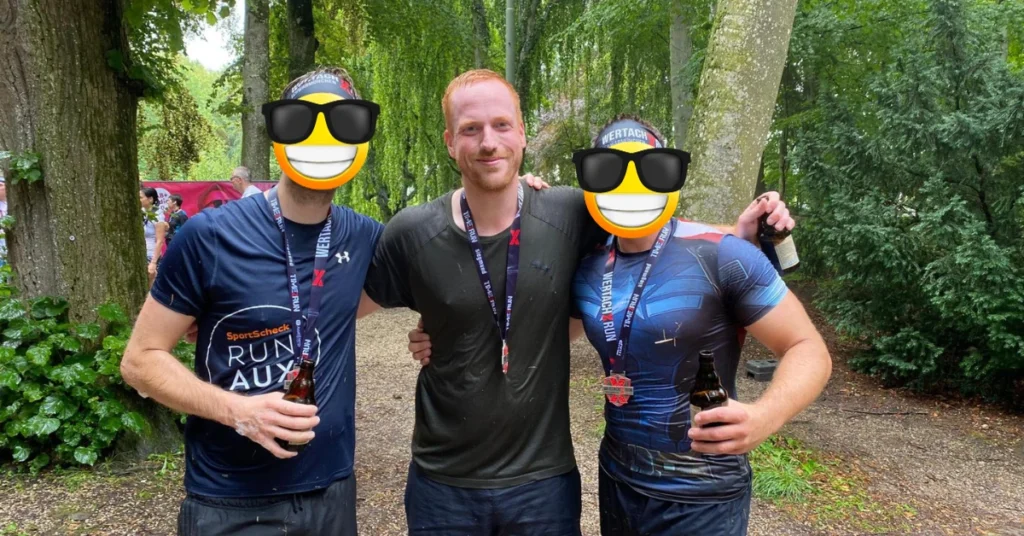
“Running is our passion. We always want to get better and reach our goals. We want to do the same for you and help you!”
🏃♂️ Marathon Vs Half Marathon
While both races are long distances, there are significant differences between a marathon and a half marathon that impact your pacing and training. A half marathon is 13.1 miles (21.1 km), making it just over half the distance of a full marathon, which is 26.2 miles (42.2 km).
Because of the shorter distance, runners can typically maintain a faster half marathon pacing compared to a full marathon. Training for a half marathon also demands less time and mileage than preparing for a full marathon, making it an excellent option for beginner runners and those with limited schedules.
👟 Running Form and Technique
Proper form and technique are essential when running a half marathon. Good running form can prevent injuries and improve your overall efficiency. The half marathon requires a delicate balance between conserving energy and running close to your lactate threshold. Here are a few key elements of running form and technique for half marathons:
- 👨🏫 Posture: Stand tall and maintain a slight forward lean from your ankles, not your waist. This position helps engage your core and keeps your chest open for easier breathing.
- 💪 Arm Swing: Keep your arms relaxed and bent at a 90-degree angle. Swing them forward and backward in sync with your legs, avoiding any excessive side-to-side movement.
- 👣 Foot Strike: Aim for a midfoot strike, landing with your foot directly beneath your body. This reduces the impact on your joints and conserves energy.
- 🏃♂️ Cadence: A higher cadence (steps per minute) can help reduce the impact on your joints and promote a consistent rhythm during your half marathon. Most experts recommend a cadence of around 170-180 steps per minute.
Remember that your running form and technique may vary depending on your individual strengths and weaknesses. Consulting a run coach or joining a local running group can provide personalized feedback to optimize your half marathon pacing and performance.
Pre-Race Preparation

🏃♂️ Role of Training
In order to prepare for a half marathon, it’s crucial that we focus on the right training regime. A well-designed half marathon training plan can help us build our endurance, strength, and speed. These plans usually involve a mix of easy runs and speed training.
It’s important to complete the designated number of easy runs each week, as these help our bodies recover and prevent injury. Speed training, on the other hand, is essential for improving our half marathon pacing and overall performance.
👟 Setting the Race Pace
Determining the appropriate race pace is key to a successful half marathon. By entering a recent 5K or 10K result, we can get a reliable estimate for our target race pace. Maintaining this pace throughout the race can help us achieve our desired finish time.

🚦 Focus on the Start Line
When race day arrives, it’s essential that we stay focused and ready for the challenge ahead. As we line up at the start line, it’s important to keep our intended pace in mind, and to have a plan in place for handling different course conditions or unexpected obstacles.
It’s also essential to listen to our bodies during the race, as this can help us make adjustments to our pace when necessary. A strong focus on our start line strategy will ultimately set us up for a successful race.
Half Marathon Pacing

🏃♂️ Understanding Pace and Distance
When preparing for a half marathon, it’s important for us to understand the relationship between pace and distance. The pace we set for ourselves during the race can have a significant impact on our finish time, overall experience, and the level of exertion we feel during the race.
We should aim for setting realistic half marathon pacing goals based on our current running abilities and previous race experiences. Breaking up the half-marathon distance into smaller segments, such as splits for each mile or 5K and 10K sections, can help us manage our pacing more effectively throughout the race.
📈 Pace Calculator and Charts
Utilizing a half marathon pacing chart further allows us to visualize our average target pace per mile or per kilometer, making it easier for us to monitor our progress and stay on track during the race.
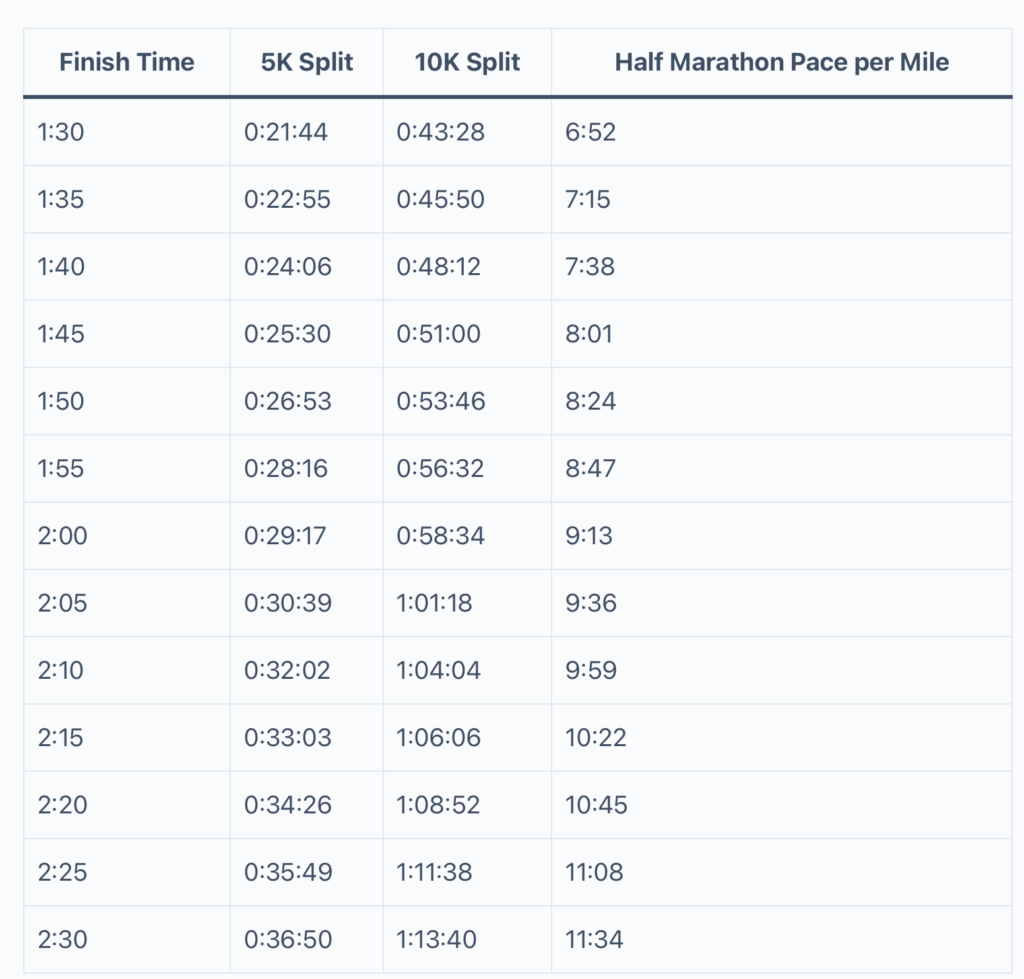
🎯 Strategies and Mistakes in Half Marathon Pacing
Developing a half marathon pacing strategy is crucial to maximizing our potential and avoiding common pacing mistakes.
Here are 2 Options for your half marathon pacing plan:
Half Marathon Pacing Constant – Ideal for new runners
- ✅For new runners, it’s recommended to aim for an even split strategy, which means maintaining a constant pace throughout the race.
- ✅By determining a target race pace, you can structure your training around this pace and avoid starting too fast and suffering later.
- ✅This strategy is suitable for rookie runners who want to complete the race without exhausting themselves.
Half Marathon Pacing Increasing – Ideal for experienced runners
- ✔️Experienced runners may opt for a negative split strategy, gradually increasing pace throughout the race.
- ✔️This strategy is common among advanced and elite runners looking to set personal records (PRs).
- ✔️Starting at a slightly conservative pace allows the body to warm up to the fast pace, and finishing strong is possible if you have extra fuel left.
- ✔️This strategy requires a good understanding of one’s own pace abilities over the half marathon distance and may be challenging for newer runners to implement.
Importance of Monitoring Rate of Perceived Exertion
- ❗️It’s crucial to monitor our rate of perceived exertion throughout the race.
- ❗️By listening to our bodies and considering external factors like weather conditions, we can make smart decisions about adjusting our pace to avoid overexertion or burnout.
- ❗️We should be mindful of potential pacing mistakes, such as setting unrealistic goals or rushing our pace early in the race, as these can impede our performance and increase the risk of injury.
Managing Your Race Day

🏃♂️ Race Terrain and Route
When preparing for a half marathon, it’s important for us to consider the terrain and route. By familiarizing ourselves with the course, we can better plan our half marathon pacing strategy. Account for hills, turns, and any potential bottlenecks that may slow us down. By being prepared, we can approach race day with confidence and optimism.
💪 Role of Perceived Exertion
As we run, it’s essential to pay attention to our Rate of Perceived Exertion (RPE). This refers to how hard we feel our bodies are working. By listening to our bodies, we can adjust our pacing to ensure a consistent effort throughout the race. This will help us prevent burnout and allow for a strong finish.
| RPE | Description |
|---|---|
| 0 | No exertion at all |
| 0.5 | Very, very weak (just noticeable) |
| 1 | Very weak |
| 2 | Weak |
| 3 | Moderate |
| 4 | Somewhat strong |
| 5 | Strong |
| 7 | Very strong |
| 9 | Very, very strong (almost maximal) |
| 10 | Maximal exertion |
Keep in mind that adrenaline on race day might make us feel like we can push harder than we should, but staying aware of our RPE will help us maintain an efficient pace.
🍽️ Dealing with Bonk and Fatigue
Bonking refers to the sudden loss of energy experienced by runners when their glycogen stores are depleted. To avoid this, it’s crucial for us to fuel properly before and during the race.
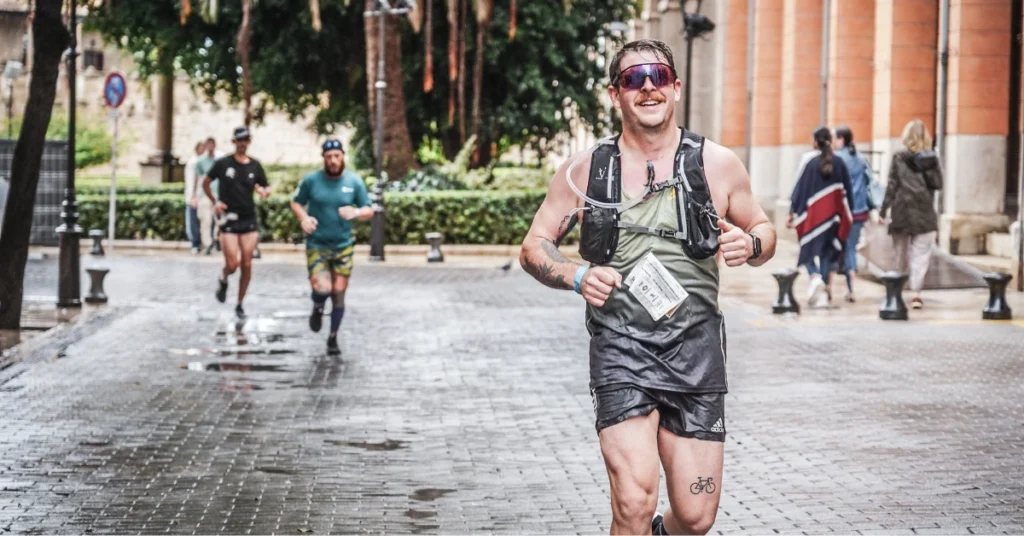
“Consume carbohydrates at regular intervals, roughly every 45-60 minutes, providing 30-60 grams of carbs per hour that we’re running.”
Fatigue is another factor that can hinder our race times. Adequate training, hydration, and mental preparation are key to preventing excessive fatigue. Remember, it’s natural to feel tired as the race progresses, but by employing techniques such as focusing on our breath or breaking the remaining distance into smaller, manageable segments, we can overcome fatigue and power through to the finishing line.
Training Techniques

As we train for a half marathon, it’s essential to focus on different aspects of our performance and build a solid foundation for our half marathon pacing strategies. In this section, we’ll discuss some key training techniques that can help us reach our goals.
🏃♂️ Importance of Long Runs
- Long runs play a crucial role in building endurance and improving aerobic capacity.
- Gradually increasing the distance of long runs helps us get accustomed to running for extended periods.
- Practicing pacing strategies during long runs helps us get used to the effort level required during the race.
🏃♀️ Incorporating Shorter Distances
- Shorter, faster-paced runs help build anaerobic threshold and improve running economy.
- Intervals, tempo runs, and fartlek workouts are examples of shorter distance training sessions.
- Mixing these workouts into our training schedule enhances overall performance and ensures we don’t plateau.
🏃♂️ Training at Lactate Threshold
- Training at or near our lactate threshold improves our body’s ability to process lactic acid and delay fatigue.
- Heart rate monitoring or perceived effort during workouts can help us find our lactate threshold.
- Gradually increasing intensity until we find the level where we can sustain a challenging but manageable effort is the key.
🏃♀️ Importance of Recovery
- Recovery is just as important as training.
- Giving our bodies adequate rest and ensuring proper nutrition helps us stay injury-free and improve overall performance.
- Combining these techniques prepares us to conquer the race with improved pacing and endurance.
Our Opinion on Half Marathon Pacing
We believe that having a solid half marathon pacing strategy is crucial for a successful race. When coming up with a plan, it’s essential to consider various factors such as your current fitness level, recent race times, and specific goals for the race. A well-thought-out half marathon pacing strategy can make a huge difference in your performance and overall race experience.
When developing your pacing strategy, it’s essential to keep in mind the importance of consistency. A common mistake for many half marathon runners is starting too fast and burning through energy reserves too quickly. Maintaining a steady pace just at the edge of your lactate threshold is the key to success in a half marathon.
Here are a few tips that we think can help you with half marathon pacing:

Split the race into sections: Instead of approaching the race as a single 13.1-mile challenge, break it down into smaller chunks.
Practice your goal pace: During your training runs, incorporate specific workouts at your target half marathon pace.
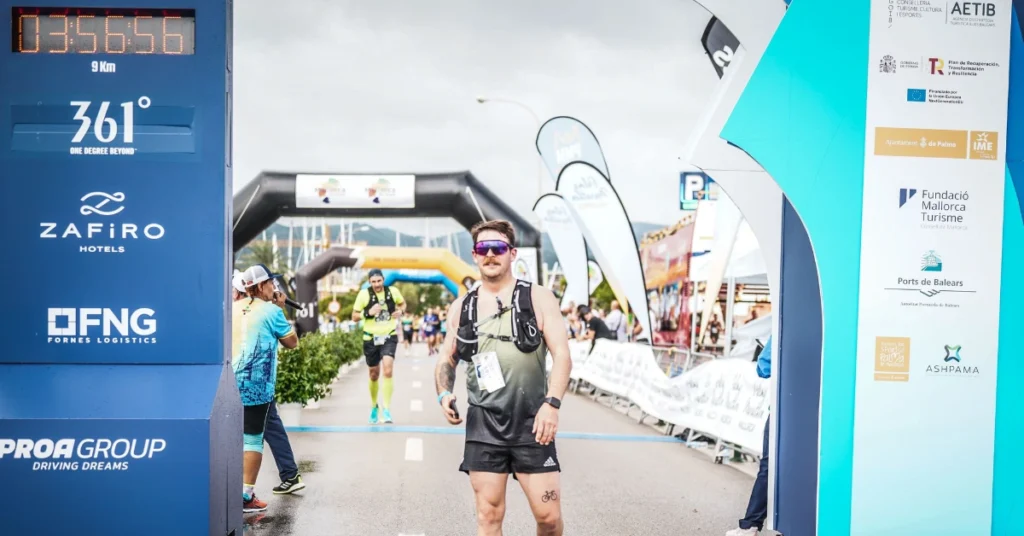

Use a pacing wristband or app: Utilize tools like a pace chart or app that will guide you through your race at a consistent pace.
Listen to your body: If the pace feels too fast and unsustainable, adjust accordingly to prevent burnout or injury.
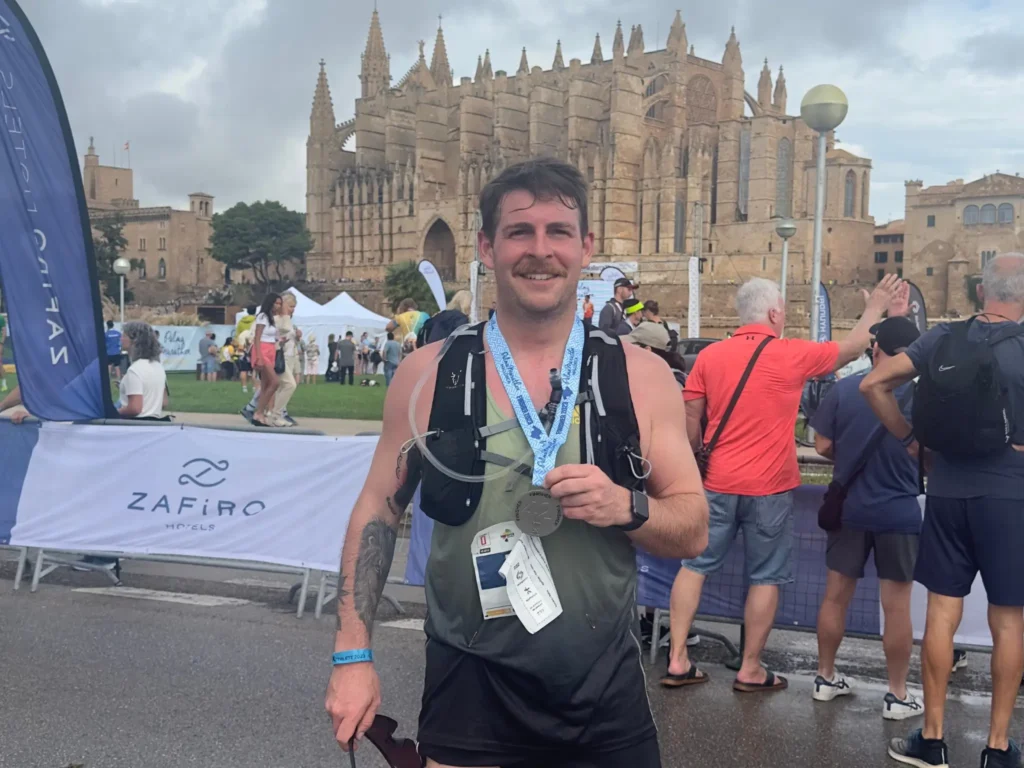
A well-executed half marathon pacing strategy, combined with efficient training, can significantly improve race performance and enjoyment. Keep these tips in mind as you prepare for your next half marathon, and remember to always keep your expectations realistic and focus on running your best race possible!
FAQ
What is the best way to pace yourself during a half marathon?
Start slow and gradually increase your speed. Aim for a negative split, running the second half faster than the first.
How do I calculate my half marathon pace?
Divide your target finish time by 13.1 to get your pace per mile. Use a running app or GPS watch to track your pace during training and the race.
Should I run with a pacer during a half marathon?
Running with a pacer can help you stay on track and avoid going out too fast. Choose a pacer who has a similar goal time and follow their lead.
What is your option on the Half Marathon Pacing? I would love to hear it in the comments. I’m sure you also like reading about Half Marathon Calorie Burn or our Marathon Checklist.




Good news ..go runners
Hello Rien,
thank you for your comment.
We are very pleased that you liked our article.
Please stop by again at any time and let us know if you like something or are missing something.
Best regards, your runfitjourney team.
Overall, good article and liked the section on t
Lactate threshold. Please consider age and gender when finding one’s pace for the race. Also, remind readers not to compare their pace time to what it was in the past. Look at what is a good pace based on age range and gender as a good goal to have. Thank you!
Hello Peg,
Thank you for your comment, which made us very happy.
Very valuable input from you, which I will definitely include in the next article update!
Sebastian from the runfitjourney team wishes you many greetings and many great miles
Or you can run based on effort and how your body feels. Your body doesn’t know what pace is; it only knows what effort is.